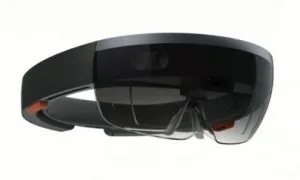Since Google pulled Google Glass out off the limelight, Microsoft has stepped in by announcing its Microsoft HoloLens device during the Windows 10 announcement.

It is kind of interesting to see which announcement was actually hiding behind the other.
With many talks and tests about the HoloLens device being published, it has taken over the marketing drive from Google Glass as the front runner in the augmented reality field. It seems a new product with great potential has to come from an already successful company. Other existing AR headsets, such as those from Vuzix and Epson do not seem to tickle the interest of writers and analysts nearly as much as a device from a leading company. And since Apple is not playing in this field at the moment, it is Microsoft’s chance to steal the show.
When Google announced the Google Glass, the announcement of the explorer program was seen as a way to create apps that would then, in turn, drive consumer adoption. For now, we can say that this strategy didn’t work out as Google had hoped.
Microsoft is taking a quite different approach with Hololens compared to Google with Glass. Instead of making the device as invisible as possible, HoloLens looks more like a massive safety glass helmet that leaves no questions about what the user is wearing.
 Source: Microsoft
Source: Microsoft
So far, Microsoft has shown quite a few potential applications for using the device at home. Creating a virtual whiteboard and reminders, providing information and as a communication platform – it seems the use model is not so different from Google Glass after all.
However, instead of offering an explorer program for app developers, Microsoft is taking a step back by enticing researchers to take a good look at the HoloLens device and augmented reality in general. They are offering funding for research projects and are asking for proposals from the academia to “better understand the role and possible applications for holographic computing in society. Additional goals are to stimulate and advance academic research in mixed reality and encourage applications of holograms for novel purposes.”
Microsoft is asking for proposals and will award the top five proposals with a maximum of US$100,000 and two HoloLens devices. They expect the research program to seeking additional funding, but awards are “one shot” deals. They do not ask for any direct return, but are saying that they will be using and potentially publishing the winning proposal ideas.
From a general perspective this seems to be a very basic approach to introducing a new technology. Creating academic research data will support the usage of new technology in the midterm, but it is unlikely to achieve any immediate boost from this approach.
The areas that they are promoting (however, other topics are also accepted) are:
• Data visualization
• Evolution of pedagogy in STEM, medical, and design education
• Future of communication and distributed collaboration (Remote training, emergency services)
• Interactive art and experimental media
• Psychology-related topics (Human machine interaction)
• Solving difficult problems and contributing new insights that are specific to the applicant’s field
None of these topics covers typical consumer applications. Instead it seems that they are looking more at the professional and enterprise markets instead of the consumer. This is a very interesting and somewhat unexpected turn. From this, one could derive that Microsoft is actually following Google and other AR player’s playbooks by going strongly after commercial applications. We will see which markets Microsoft is approaching, once the device becomes available. – NH

